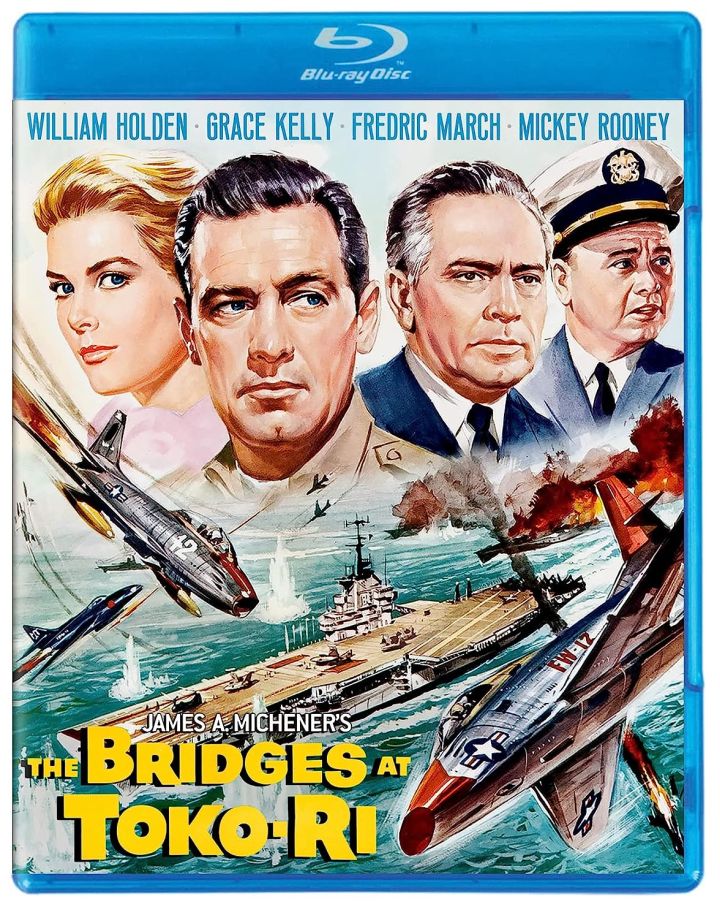
Korean war movies all tend to have a sense of ambivalence. WWII movies, even when they have obligatory scenes of the horrors of war, don’t tend to be confused about why the fight is taking place. The Korean war is (on the surface) more complex, less clear. And the movies that came from it don’t have as distinct a sense that it was, indeed, the good fight.
The Bridge at Toko-Ri‘s story, based on a novel by James Michener, is all about that ambivalence. Lieutenant Harry Brubaker (William Holden) is a WWII combat flying vet who left the navy but was recruited back in for Korea. And he hates it. He wants to be home with his wife and kids, not flying dangerous combat missions, performing terrifying landings on aircraft carriers. We first meet Brubaker when he doesn’t make a landing and has to ditch his jet (a Panther) in the ocean. He’s rescued by a helicopter flown by Mike Forney (Mickey Rooney) and is brought back nearly frozen to the carrier. He’s miserable and ready to leave the military whenever possible. Only a visit from his wife (completely against regulations) helps him keep some semblance of balance.
That wife, Nancy, is played by Grace Kelly, who is absolutely luminous on screen. She and Harry barely have any time to themselves, between their children and Brubaker’s various duties (official and personal) with his fellow crewmates. Nancy has insulated herself from the realities of the Korean war. However, after a frank conversation from the admiral about the real dangers Harry faces, she tries to insert herself more directly. She wants to understand what he really faces, and the pressure he’s under.
That pressure is the focus of the last third of the film, where the mission at the titular bridges at Toko-Ri takes place. As competent a flyer as Harry is, he’s justifiably nervous about the run. And after a near disaster carrier landing, his nervousness develops into full PTSD.
The Bridges at Toko-Ri is a curious war film. It has the parameters set – the highly skilled warrior, the terrible mission. He’s got the girl he’s fighting for and the men he’s fighting with. But Holden’s Brubaker is all reluctance, at least for the warfighting. He doesn’t want to be there. He doesn’t have much faith in a cause. He wants his wife (it’s Grace Kelly, I’d want her, too); he wants his home. He doesn’t want this fight.
The fight, by the way, looks excellent. The Bridges at Toko-Ri, filmed just a couple of years after the end of the war, had an incredible amount of support from the U.S. Navy. The film was shot on real carriers, using real Navy Jets. There’s an abundance of actual footage of aerial maneuvers, blended often seamlessly with model work that won the film an Academy Award for Special Effects. William Holden even learned how to taxi a jet on a carrier so he could be the man in the cockpit for scenes preceding take-offs.
The director, Mark Robson, has maybe a little infamy for being one of the editors (along with Robert Wise) who created the cut of The Magnifcent Ambersons that Orson Welles famously disowned. He later became a director for Val Lewton’s film unity at RKO, directing several low budget horror films including The Seventh Victim and The Leopard Man. In this film, he skillfully weaves together a story of rather large scope while keeping the character relations intimate and relatable.
The film is about duty and responsibility. But it doesn’t pretend that there are easy answers to why men fight in their country’s wars. It lauds them. The last lines of the admiral after the mission are “Where do we get such men?” But it’s not clear whether these men are properly spent in these battles. There are justifications for the war, but the film doesn’t white-wash the toll fighting it has on the warriors.
The Bridges at Toko-Ri has an exceptional balance of drama and tension. In particular, the final mission has some white-knuckle action. This contrasts with the constant calm professionalism of the pilots, even as things do not go well. It has the action and excitement of a war film. But it doesn’t shy away from the dramatic cost of war on its participants. And, as a bonus, the near documentary aspects of the workings of a ’50s aircraft carrier are fascinating to watch. It’s an exceptional war film for its time.
The Bridges at Toko-Ri has been released by Kino Lorber Studio Classics. Extras on the disc include a fine commentary by film historians Steve Mitchell and Steven Jay Rubin, as well as trailers.